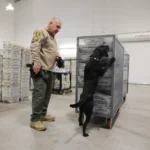Out of the Wilderness of Alcohol Addiction
A Jackson Hole resident finds himself—and finds his way home
- Published In: Other News & Features
- Last Updated: Sep 27, 2023
By Alec Klein
Special to the Wyoming Truth
Editor’s Note: This story is part of an ongoing series about the impact of the lack of inpatient rehabilitation treatment centers in Jackson Hole. It discusses drug addiction, alcoholism and bullying. Reader discretion is advised.
There might not be a place more beautiful than Star Valley, or so Chad thought as a child growing up in the embrace of its majestic mountains, in the sweep of farmland as far as the eye could see, the evergreens so emerald, the Snake River so crystalline.
Indeed, it was such a magical place that, over a century ago, in the 1870s, Mormon pioneers, including Brigham Young Jr., paused, took in the epic scenery and decided it was good. They selected this Wyoming valley, near the Idaho border just minutes away from Jackson Hole, for settlement. The place was proclaimed, “The Star of All Valleys,” such was its natural wonder. Later, the story goes, it simply became known as “Star Valley.”
A darker version explains the origins—that the winters were so bitter, the region became known as “Starvation Valley.” “Star Valley,” for short.
Chad came to know this place.
Stepping out of high school one day, he approached his Chevy Silverado in the parking lot. That’s when he took notice: The severed legs of a deer had been shoved in the exhaust pipe.
In the back of the truck, someone had left a message for Chad, written in the deer’s blood:
“F-g.”
Chad, then a junior, was 16.
What do you do with such shocking hate? How do you react to that kind of unspeakable savagery?
Chad extracted the deer’s legs from the tailpipe, threw them in the back of his truck and drove away.
“It was just another day,” he said.
And Chad told no one about it. “I couldn’t go away and say anything about it,” he said. “It would only make things worse.”
It was about 2004 in a deeply conservative town carved out of the wilderness. Chad put it this way: “It’s like stepping through the wardrobe to Narnia,” referencing the fantasy world rendered in C.S. Lewis’ classic children story.
At first, the alienation was almost imperceptible. People didn’t say anything, but their distance spoke volumes; they didn’t accept Chad. He felt apart. Not invited to parties. Not allowed to become close to others. But then the taunting began in high school. Other kids would follow him and call him names. They reminded him that he was gay in language that can only be described as cruel.
By the time he was a sophomore, the invective was a constant drumbeat. Kids would spew out labels of hate at him all day long. So, a year later, by the time he confronted the severed legs of the deer, he didn’t react—not overtly.
“That’s how it was,” he said. “I didn’t know what suicide was. If I did, I probably would have thought about it and done it.”
Instead, Chad turned to something else — whatever you want to call it — an escape, a way to self-medicate, an addiction.
“It was awful, it was awful,” he said of it all—the isolation, the abuse, the suffering. “It was the reason I became an alcoholic.”
An oft-overlooked addiction
Alcohol, in some ways, has become an oft-overlooked addiction—at least in much of the media.
Taking center stage in recent years has been the alarming rise of fentanyl and other opioids, which are penetrating the borders and killing tens of thousands of Americans every year. Nearly 110,000 people died last year in the United States as a result of drug overdose deaths — most as a result of synthetic opioids — according to the Centers for Disease Control and Prevention. The deaths have often come almost instantly. Often involving teenagers. Often involving people who are not addicted to drugs but experimenting.
And yet, alcohol kills more. Worldwide, about 3 million deaths every year are attributed to the harmful effects of alcohol, according to the World Health Organization, a United Nations agency. That accounts for about 5% of all deaths globally.
In an average year, about 140,000 people in the United States die due to the use of alcohol. Each day, nearly 400 Americans die because of excessive alcohol use. Liver disease. Poisoning. Car accidents.
What’s more, one in 10 Americans over the age of 12 suffers from alcohol use disorder, according to the National Center for Drug Abuse Statistics.
Wyoming is far from immune from the problem; the state owns one of the highest per capita rates of alcohol-related deaths. And where Chad lives today — in the Jackson Hole area — a higher percentage of adults reports binge or excessive drinking than that of the state or nation, according to a countrywide report issued by the University of Wisconsin Population Health Institute earlier this year.
It’s a jarring juxtaposition for the state’s no. 1 resort attraction, a place blessed with incredible natural beauty and fabulous wealth but also a town that struggles with substance use. Jackson Hole, in many ways, offers the mirage of limitless possibilities. But for all that it possesses — fancy restaurants, luxury vacations, white water rafting —there is no inpatient drug and alcohol treatment center here.
Chad, for one, insists it wouldn’t be effective anyway.
Tough love
Today, Chad is 35 years old, the owner of a successful — and elite — salon, Tricho, in the tony downtown of Jackson. Chad’s clientele is high-end—nay, exclusive. He has his fair share of celebrities. Even more, counted among his regulars are those rarified individuals who are so mindbogglingly rich, you don’t even know their names. A $1,000 tip? Pshaw. Chad is acquainted with such casual generosity. Chad has done well for himself since opening Tricho about five years ago; he is, in short, a savant with clippers. A hair-color virtuoso.
But here’s the thing. None of that matters. Not really. What counts is, Chad is home in Jackson Hole. He’s found acceptance here. He’s discovered community. He’s something of a local celebrity himself.
“This community has done nothing but good things for me,” he said. “Oh my God, there is nobody more popular in Jackson than me.”
Chad, of course, is exaggerating for effect. But there’s a kernel of truth in the assertion. Where he faced unrelenting vilification in Star Valley in his youth, just minutes away by car, he is embraced with love in Jackson in his adulthood.
Tough love, perhaps.
Yes, he did inpatient rehab stints. Thirty days at a facility in Palm Springs, California. Thirty days at a center in Memphis, Tennessee. But that’s not what saved him. Not by his reckoning. To Chad, inpatient rehab is too insular, lacking in real-world stresses, the kind that can provoke his alcohol addiction.
He gives credit to the attorneys and prosecutors and judges who have shown compassion for his alcohol addiction over the years. He credits the communal nature of the small town that is Jackson, for the way people look out for each other. He wasn’t simply punished when he got caught with one DUI after another. He was required to seek outpatient treatment, which has been an integral part of his life for several years: individual therapy, group therapy, mental-health checks, prescriptions and breathalyzers.
“I’m one of the few to survive this and got through it,” he said. “It’s really a hard road. But I live in place that forced me to do it.”
Chad, now in recovery, said alcohol doesn’t have an iron grip on him anymore. “I look at alcohol like I look at Clorox,” he said of the pungent disinfectant. “I will drink Clorox before I drink alcohol.”
Still, he said, the addiction is never gone for good.
Fitting in
Flashback. Born in Jackson and raised in Star Valley, Chad just wanted to be like the other kids in the neighborhood.
Which meant becoming Mormon.
His family didn’t practice any particular faith. His dad was a general laborer for a communications business; his mom worked in finance for the local power company. But his friends were member of the Church of Jesus Christ of Latter-Day Saints. So was his basketball coach. So, at the age of 8, Chad embarked on a new path, taking a series of classes to learn his new faith, getting baptized, dressing up in a white oxford, black slacks and a tie and attending church on Sundays.
“I became Mormon so that I would fit in,” he said.
Becoming Mormon, to be sure, meant more than that. The church, headquartered in Salt Lake City, Utah, was founded in 1830 and has grown to become one of the largest Christian denominations in the United States, with over 17 million members. Jesus Christ is at the center of church theology, but there are differences between Mormonism and other Christian groups. For instance, church canon includes the Book of Mormon, material that church members believe God revealed to Joseph Smith, the church founder.
Chad’s parents were fine with his new faith. Chad thought more of it—that he was on his way. He attended theology classes. He could see his future, how he would go on a mission, as did his Mormon peers, after high school. He imagined what was to come; he would become a dentist. Back then, he held down a part-time job making about $8 an hour as a dental assistant. It was a good job. He liked the responsibilities. But then something happened. Chad began to grow up and come to understand who he was.
‘Hustling for happiness’
Flashforward. Chad has returned to Star Valley maybe six times in the past 20 years—for holidays like Christmas and Mother’s Day. That’s about it. And when he makes the 15-minute jaunt, he doesn’t stay long.
“I eat and I leave,” he said.
In fact, he makes sure not to stay long enough to even stop for gas. He makes a conscious decision to fill up before making the trip. One less minute in a place that reminds him of his painful past.
“That’s how much I hate it here,” he said.
Chad didn’t just leave the place. He left the religion for good, too. The church maintains rules about sexual conduct, such as forbidding pre-marital sex and, while it acknowledges same-sex attraction, it does not condone same-sex behavior. The church quotes M. Russell Ballard, one of its leaders, who said, “Let us be clear: The Church of Jesus Christ of Latter-day Saints believes that the ‘experience of same-sex attraction is a complex reality for many people. The attraction itself is not a sin, but acting on it is. Even though individuals do not choose to have such attractions, they do choose how to respond to them. With love and understanding, the Church reaches out to all God’s children, including [those with same-sex attraction].’”
For Chad, apart from the church, there was no eluding the emergence of his addiction—what he calls his “nasty demons.”
As a pre-dental college student in northern Wyoming, Chad was introduced to a roommate who introduced him to the crushed form of Adderall, a drug to treat attention deficit hyperactivity disorder, or ADHD. They would snort it and get high. In Chad’s case, he also got hooked.
“It was just to feel normal,” he said of the addiction. “It calms you.”
The drug didn’t just make Chad feel more focused. “It made me someone who had something that people wanted,” he explained. “Everybody likes the guy who has the drugs, right?”
That’s when the slow descent began. First, he gave up on dentistry. Later, while working on a dude ranch, he got pulled over for his first DUI. He had been drinking wine. He spent a night in jail. He was about 21.
Scrambling to find a new calling, Chad hit on the idea of attending beauty school; he figured it was one of the few options where he could start school at almost any time.
It just so happened the salon where he was trained was owned by a Mormon family, and the father was particularly hard on Chad, threatening to kick him out at various turns, assigning him menial tasks, like cleaning toilets, and excoriating him for his tattoos—another no-no in the Mormon church, in which the body is considered a temple and gift from God.
On Chad’s left forearm, his tattoo read: “Hustling for happiness since 1988,” the year of his birth.
The salon owner’s reaction: “You might as well as get a cupcake tattooed on your face at this point.”
As it happened, Chad did get tattoos all over his body, except the front of his face and throat.
As it also happened, Chad had a gift as a stylist—so much so that he developed a following when he got his first full-time job and, even more, when he opened his own salon, Tricho, about five years ago.
The lifestyle, though, was pressurized and frantically busy, lending itself to a drink at the end of the work day. A way to wind down. A glass of wine. Pinot Noir. Everybody, he said, did it. But what started as a glass turned into a bottle, and a bottle morphed into a night of drinking into oblivion. Which became a habit.
Then came another DUI.
And another.
And another.
The cycle repeated itself over and over—until, in about 2020, when he lost something so precious to him: Someone he loved. His partner didn’t think Chad was taking his sobriety seriously. Chad’s partner left him.
“I lost this person I loved,” he said.
Only then did he stop drinking.
“Every addict has to decide they’re sick of it,” he said. “That they’re done with it.” It won’t happen, he said, “until you’re ready to change.”
The letter
Back in time. About a week after Chad found the severed deer legs in his exhaust pipe, he was heading out of the high school building, again. Into the parking lot, again. He came across a dead animal in his truck, again.
This time, it was a chicken.
“There was blood everywhere,” he said.
All over the bench seat. Near the steering wheel. All he could think to do was wipe up the blood.
“It didn’t hit me hard at all,” he recalled.
Chad, then a junior in high school, had already endured years of hateful epithets. The dead chicken, in his view, was a physical manifestation of what he had already experienced verbally.
It had, he said, “already made me numb.”
Not long after, when he was about 18 years old, Chad wrote a letter to his parents. He typed it because “I was afraid to say it out loud.” He left the letter on a table in the living room between two chairs, where his parents liked to sit. And then he departed for his part-time job.
Chad doesn’t remember the specifics of the letter, other than this: that he told his parents he is gay. That “this is who I am.”
But he remembers this: “I felt relief,” he said, “because I was sick of carrying that around for so many years.”
His parents already knew. So did his older brother. They weren’t surprised. Chad’s parents did tell him that they were sad that Chad, their son, felt he could only tell them in a letter, not to their face. They also wanted him to know one thing: We love you.













